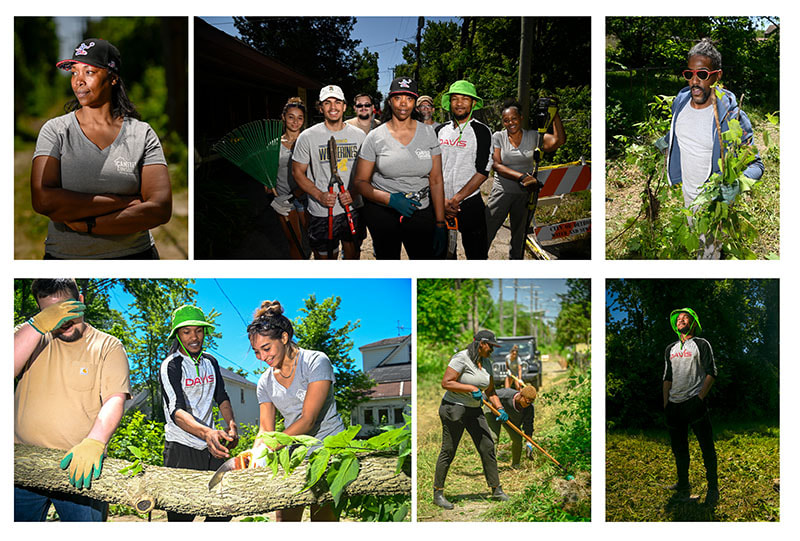|
BY BRYAN GOTTLIEB // PHOTOGRAPHY BY DARREL ELLIS Urban Acupuncture Revitalizes Detroit AlleywaysWithin neglected quarters of Detroit, hyperlocal revitalization efforts to restore parts of the city’s sprawling alleyway network are reinventing their purpose in the process Rhonda Theus reminisces fondly of her youth growing up in Detroit’s East Canfield Village neighborhood, where get-togethers with extended family and close neighbors along her block on Montclair Street included barbecues, mingling, and relaxing in the alley behind their homes. “The alleys were social spaces, you know,” Theus, says. “We would all have our grills out there, play, and sit and talk; they were social spaces when we were growing up.” In the Detroit of Theus’ childhood, the city was a much different place. Its population exceeded one million residents, enjoying a more substantive tax base that afforded robust municipal services, including maintaining 9,000-plus alleys within its 138 square miles. The story of post-industrial Detroit, its population decline, and its inability to consistently maintain essential infrastructure, has been well documented. This is not that story. Rather, this is an account of grassroots pluck spurring civic renewal. Over the last decade, residents have increasingly taken matters into their own hands to drive revitalization with the help of hyperlocal nonprofit organizations. This evolution departs drastically from the traditional urban planner’s script. Large-scale renewal projects, requiring significant infrastructure modifications, were once the go-to panacea for many big-city mayors. These capital-heavy, master-planned investments incorporate the alluring premise that, through transformation, a ripple effect will benefit adjacent neighborhoods. The approach still garners the headlines but is now just one of many arrows in the urban planning quiver. For every Little Caesar’s Arena or Campus Martius Park — and the tax credits or municipal bond issuances funding them — there are also many targeted micro-projects that often have a more significant impact on livability for the city’s residents. Paul Draus, a professor of Sociology at the University of Michigan-Dearborn, should know since he is one of the change-makers standing in the vanguard of a concept known as “urban acupuncture.” “Urban acupuncture is the idea that, within a city neighborhood, you’re trying to achieve a systemic change to enhance the functioning of the overall system,” he says. “You don’t have to necessarily target everything in the system. You can have very directed sort of points of intervention that help stimulate the underlying system, all of which lead to a transformation.” As an academic endeavor and personal passion, Draus has been the lead author on numerous journal publications outlining the benefits of small-scale revitalization projects like alleyway restoration, squarely falling within the urban acupuncture framework. The term, first coined by the noted Spanish architect Manuel de Solà-Morales, was established in practice by the Brazilian politician and urbanist Jaime Lerner, whose tenure as mayor of Curitiba, in Paraná state, demonstrated proof of concept through countless small-scale renewal projects. Draus first encountered the term while attending an urban ecology conference in Poland last summer. “I realized very quickly that what we were doing in terms of alley [restoration] was, in fact, urban acupuncture, without giving it that name,” he says. “Urban acupuncture is the idea that, within a city neighborhood, you’re trying to achieve a systemic change to enhance the functioning of the overall system,” he says. “You don’t have to necessarily target everything in the system. You can have very directed sort of points of intervention that help stimulate the underlying system, all of which lead to a transformation.” In Lerner’s eponymous book on the topic, published in 2016, the politician noted that “pinpricks” of urbanism can have rippling effects, restoring and revitalizing once-blighted areas. Draus and others have weaved in concepts to their urban acupuncture that incorporates biodiversity, eco-friendly water retention and rainwater collection, renewable energy installations, and economic engine opportunities like farmers markets. Draus is a leader in the concept of “alley activation,” which, simply put, is the restoration of an alleyway that has fallen into disrepair due to neglect, illegal dumping, and vegetative overgrowth. The concept of urban acupuncture, borrowing the traditional Chinese medical application as a metaphor for targeted, isolated healing, includes the restoration of neighborhood alleys. As Theus explained, alleyways offer far more benefit to residents beyond their original, utilitarian purpose. “In Detroit, [alley abandonment] was a signifier of urban decline, disinvestment, and blight,” Draus explains. “So, alley activation is the idea of taking back that space and reimagining what it [can become] because the original uses of the alley may no longer be relevant.” One of his alley activation collaborators is Korey Batey, founder of the nonprofit Detroit Ain’t Violent It’s Safe, or DAVIS, whose interest in alley restoration was initially born out of practicality versus activism. Previously, Batey was a line installer for Comcast. His work was made significantly more challenging due to the poor state of many alleys, littered with trash and unwieldy vegetation. “My job as the cable guy going into these alleys so over-grown with trees and other vegetation — not to mention all the illegal dumping — all while trying to lay cable wire clued me in immediately to the necessary benefit that creating a nonprofit organization would provide in terms of tapping into resources to support cleanup efforts,” Batey says. In addition to founding DAVIS in 2019, Batey also took a position with the city of Detroit as a de facto ombudsman for residents looking for resources to help restore their alleyways. He estimates that of the 9,000-some-odd alleys throughout the city, he has personally surveyed nearly 3,000 of them. Back in East Canfield Village, Rhonda Theus and her younger sister, Kim Theus, wanted to restore the community they remembered from their childhoods. Years of neglect have taken a toll on the neighborhood. When Kim returned to Detroit in 2019 after spending many years living in New York City, first for college at New York University and then pursuing a career, she and Rhonda formed a nonprofit called the Canfield Consortium. “We’re honoring the legacy of these homes and the people who made this community so special,” Kim says. “Because of the decline in the city of Detroit, it sparked us to co-found Canfield Consortium to focus on developing this community because there are amazing people here who have a deep love for the community as well as the homes that they live in.”
After three years of research, planning, and drafting proposals, Canfield Consortium recently secured the funding it sought through a $50,000 grant from the Salazar Center for North American Conservation’s “Thriving Cities Challenge” in June. Later that month, the Theus sisters, along with Batey of DAVIS and Draus, commenced the first phase of the Montclair alley activation. The collaboration is one example of the grassroots nature typical of urban acupuncture projects: small, nimble, and easily implemented versus more traditional urban infrastructure projects like building a “Renaissance Center” or constructing sports complexes. Among the dozen volunteers at the Canfield site were a handful of Draus’ students from his urban sociology classes, including 21-year-old Marlena Brown, a third-year student at U-M Dearborn who plans to pursue a career in urban planning after graduation. Like the others active in this movement, Brown is unabashed in her commitment to the urban acupuncture concept as a catalyst for change. “Alleyways have always been a huge necessity for cities, and … they can now find new purposes that will help benefit community growth and interaction in unique ways,” Brown says. “The aspect of urban acupuncture I find most appealing is how it encourages small-scale interventions that transform communities and, eventually, transform a city.”
0 Comments
Leave a Reply. |


 RSS Feed
RSS Feed

